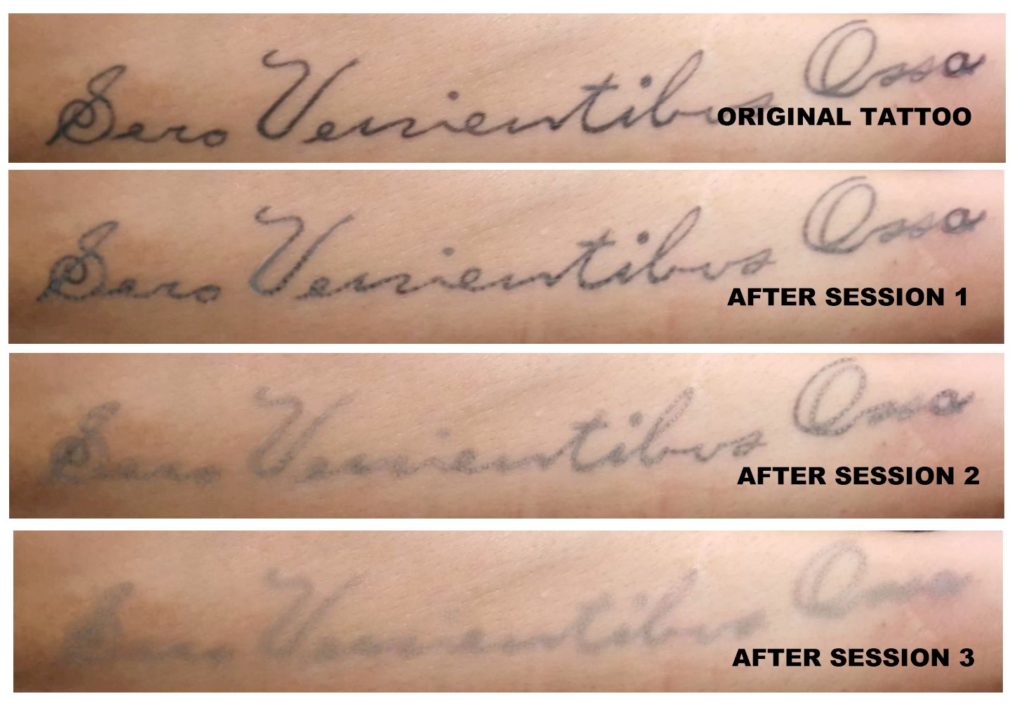Tattoo Removal
Tattoo removal is a specialist service and is only done by appointment.
Please read all the following content carefully so that you are fully aware of the process, its advantages and disadvantages.
The Tattoo Removal Process
You need to understand the following
How long does tattoo removal take?
Each session will take about 30 min for every 50mm x 50mm of removal
A normal tattoo will require about 3 to 5 sessions and each session should be a minimum of 4 weeks apart so a normal tattoo will take about 6 months to remove
How much will tattoo removal cost?
Tattoo removal costs R500 for every 50mm x 50mm area processes, of the area processed only 30% will have work done on a series of dots.
What is done in a removal session?
During a single session a series of regular spaced areas are selected for removal, these areas are tattooed in the same process as doing a tattoo except a solution is used instead of ink. The reason for doing these spaced dots is to help the skin repair itself more quickly and reduce the risk of scaring
Is it painful?
The removal process is equally as painful as having a tattoo applied as it is the same process, the removal solution does not contribute to the pail experienced.
Will I bleed?
During the application of the remover the tattoo needles will puncture the skin to a depth of approximately 2mm this will result in a small amount of visible blood.
Is the Process safe?
The process is safe and has had no known allergic reactions but the skin will be opened and your body will be exposed to the risk of infection and you will need to keep a close look on the the healing process which normally take 10 days
Tattoo Removal Aftercare
Immediately after treatment:
- Remove the temporary bandage placed by your technician. Carefully wash and blot dry your wounds using dabbing motions but NEVER wiping motions.
- DO NOT scrub the area or use harsh cleansing creams or chemicals on the skin. Let the wounds air dry.
- DO NOT place soothing ointments on the wound. Dry scabs are an essential part of the procedure.
- Expect the area to feel sore and look red (with inflammation) for the first few days.
- The treated wounds will form small scabs, which will drop off after 10 to 21 days.
Post-Treatment Instructions
- DO NOT scratch, pick, or rub the epidermal crust or scabs. Correct formation of the eschar scabs is critical to the success of the process.
- All scabs must be allowed to DROP OFF naturally.
- When itching cannot be ignored, LIGHTLY BRUSH or tickle the wounded area with a cotton ball. DO NOT compress or rub the cotton against your healing skin.
- AVOID restrictive or tight clothing over the treated area.
- DO NOT soak the treated area in a bath, swimming pool, or hot tub
- DO NOT expose the treated area to the full pressure of the water in a shower.
- You may gently cleanse the treated area with a mild antibacterial soap that is fragrance free. Rinse with water and lightly pat the area dry taking care not to disturb the scabs.
- DO NOT expose the treated area to direct sunlight or any other source of UV radiation (like arc welding).
- Fresh skin in very vulnerable. While reforming and maturing, the newly epithelialized areas of fresh skin will turn red, then pink.
- Keep your skin moist. You may use skin lotions.
- After the inflamed pinkness of the new skin fades to normal:
- Failure to follow these post-treatment instructions will almost certainly reduce the effectiveness of the treatment. Final results cannot be determined until healing is complete.
Tattoo Removal

Tattoo Removal History
The following is a brief history of the process that we use for successful tattoo removal
For as long as people have been having tattoos there has been a need for their removal
The oldest proof of tattoos was discovered on a man preserved in the ice for 5500 years, the oldest recorded tattoo removal process was abour 3500 years ago when it was found that Yak milke help remove a tattoo
From then various methods have been devised from
- Dermabration ( sanding the layers of the skin)
- Laser (using focused heat to burst ink molucules)
- chemical peals
- Tattoo Removal solution
Each of these processes have varying degrees of success but all result in significant scaring except the tattoo Removal process. This process has evolved through the accumulated knowledge from tattoo artists, plastic surgeons and suppliers of removal solutions.
